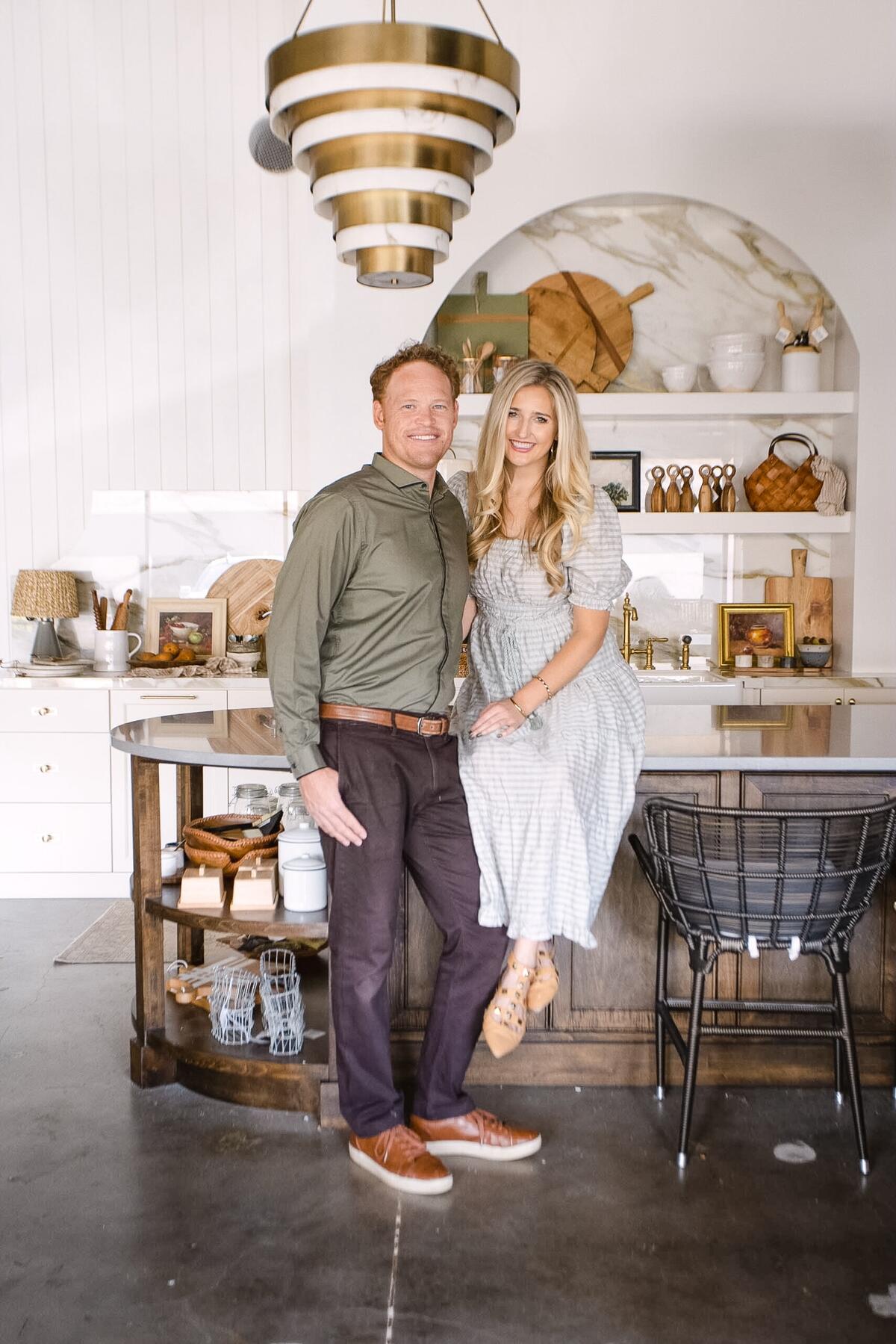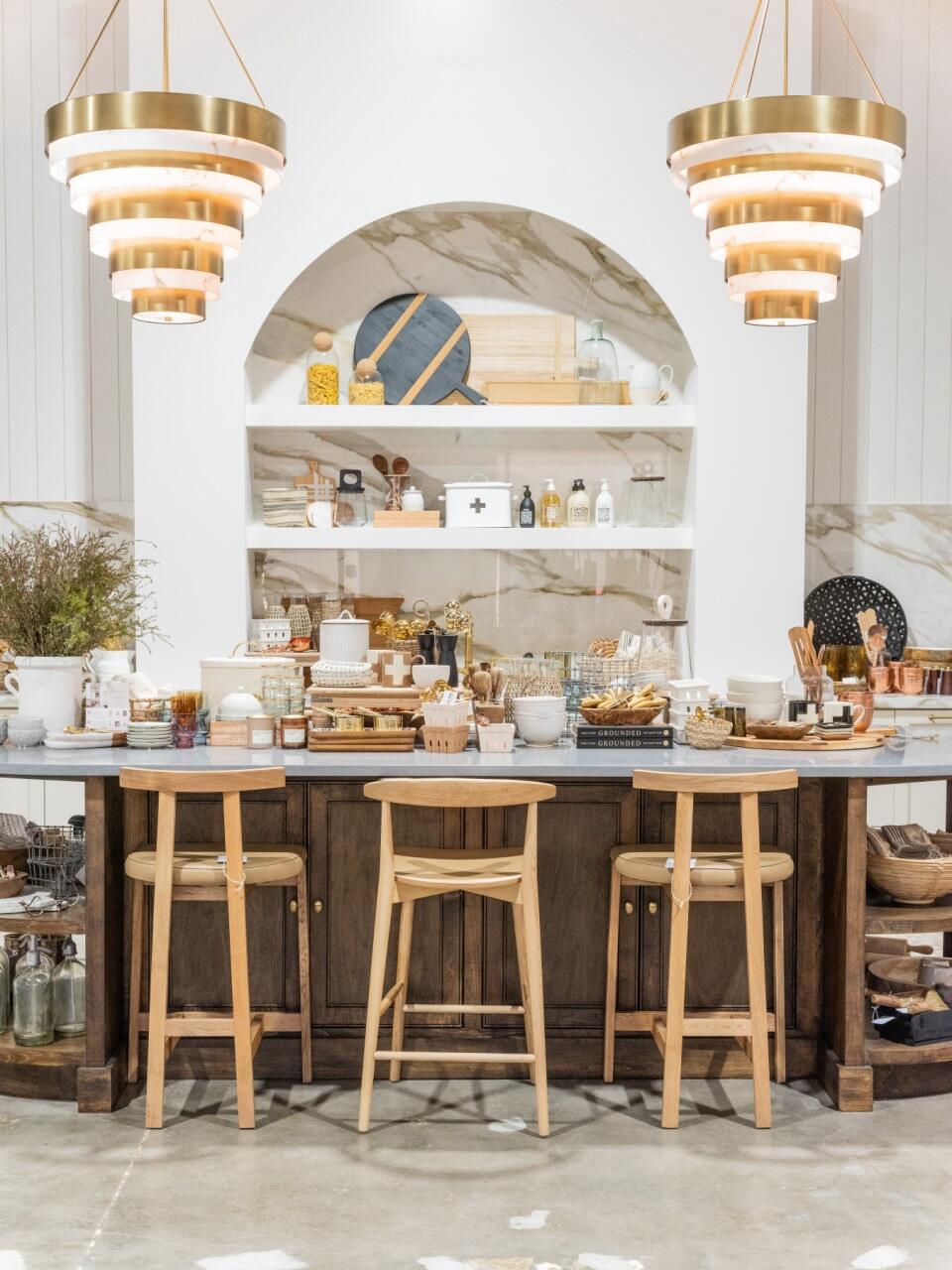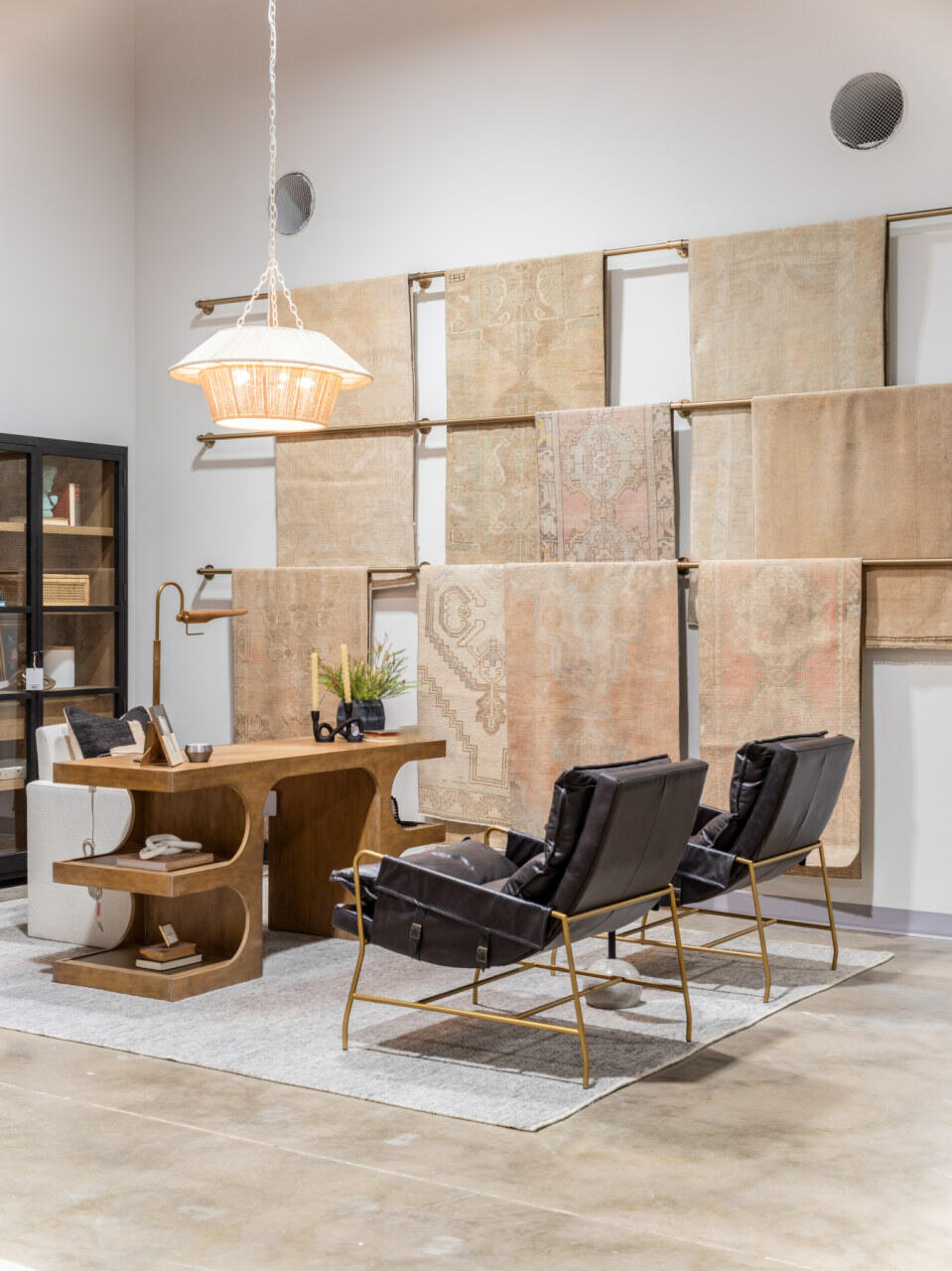In Business of Home’s series Shop Talk, we chat with owners of home furnishings stores across the country to hear about their hard-won lessons and challenges, big and small. This week, we spoke with Heather Fujikawa, who operates the Dallas-based home-furnishings store and full-service design studio House Sprucing with her husband, Tyson.

Design has long been a family affair for Fujikawa, beginning with her interior-designer mother in Salt Lake City. “Since I was 6, I was setting the table. I was helping pull accessories. I was going around to tile showrooms and picking things out with her,” she recalls. When she married Tyson in 2007, the couple got some press for the decor of their early Los Angeles apartments, attention that exploded on social media once they moved to Verona, Italy, for a few years. In 2013 they settled in Texas, where Fujikawa began designing homes, and just before the pandemic, she and her twin sister, Heidi Andrews, debuted their TV show Design Twins, which followed along as they launched their own firm.
The growth certainly didn’t end there: Four years ago, the two couples acquired and adopted the name of a local business, House Sprucing. “It was better than our other brand, which we called Habitat Studio. Everyone thought we were Habitat for Humanity and we were going to give them free design services,” says Fujikawa. It was “a perfect opportunity to change our name, because this was not working.” The first brick-and-mortar store followed in 2021, and they expanded its square footage tenfold in a new location just a year later. “We say we jumped off a cliff and built our wings on the way down,” she says.
Ahead, she looks back on these whirlwind years, reveals the magic of Dallas, and explains why connecting with her 125,000-plus Instagram followers is still so important.
What interested you about retail in particular?
I love the retail experience. I love tangible items. I worked at Nordstrom in high school, and at Gap in college, to pay the bills. When I was in my early 20s, I started a hair accessory and jewelry line with my sister, and immediately I had this passion to sell it to Nordstrom, Henri Bendel and Fred Segal. We got into those stores within a year. I think we still need to interact with people and build community and touch things and understand the quality of what we’re putting into our homes, so we can really live with it. Without understanding that quality and having that customer experience, it’s just a piece of furniture. Who doesn’t want to love every little-to-big thing in their home?
Where do you think your family’s entrepreneurial spirit came from?
My husband, Tyson, always had a passion and drive to own his own business and to provide for our family that way. He is such a motivator and so hard-core on making this happen. For him it also [stems from] being burned by corporate America. On my side, I’ve grown up with incredible generational entrepreneurship: My great-grandma and great-grandfather started one of the largest theaters in America, called the Hale Centre Theatre, and they were always in production, building these theaters that are now in multiple states.
My mom wanted to do her own thing because she grew up in that theater background. I have five siblings, and both my brothers and sister have successful companies. And then Tyson and I and my twin sister [have ours]. I think it’s in our bloodline. It’s hard to not do it!

You expanded the store into a bigger space pretty soon after opening, right?
Yeah, that was an exciting time: August 2022. We had opened our doors June 2021, and had grown out of this little 1,000-square-foot space after a year. The demand was just knocking at the door. It would be stupid not to at that point; there were just so many clients, and we were doing all this amazing work. We have wonderful VIP clients—I don’t want to share [details], but if you have that type of clientele, you’ve got to give them the red-carpet treatment.
Why do you think you were able to gain such traction right away? Were you filling a specific need, or was it a specific neighborhood?
Dallas is a boom town. We live in one of the fastest-growing cities in the U.S., and it just brews needs. When you can find a way to fill those needs, that’s when you can have a really strong business. What my husband and I have learned is that if you’re going to set up any type of business, make sure you do it in an area that has a demand that needs to be filled, and that you evaluate and understand that need. For instance, we looked at starting our business in San Diego, where my husband is from. [If we had opened there], we would have relied heavily on remodels more than new construction. My hometown [in Utah] we knew wouldn’t work because there wasn’t enough of the right demand that we wanted to serve. In Dallas, we work on a lot of new-construction homes.
Tell me about the aesthetic of the store.
I’d say new traditional and modern European. It’s subtle and elevated so that people can feel comfortable in their home, but it still feels really nice. It’s not screaming money, money, money at you. A lot of people want that [more subtle look]. They don’t want over-the-top design. We do layered design. It’s really approachable and welcoming.
How did you use the second location to build on that?
Tyson is constantly switching up vignettes and looks so that it feels fresh. When you walk in the door, it’s this beautiful styling moment. It’s the seasonal drop, then you keep moving forward from one vignette to the next to understand how rooms are put together, what pieces to put in a room. We have a beautiful kitchen area that’s so fun to shop from, with an oversize island—very Texas-scale. We of course have tons of chairs and ottomans and sofas and all varieties of colors and textures that you can touch.
Who is your typical customer?
We have some trade. A lot of it is our current [interior design] clients. So we run a roster of about 60 to 80 clients at a time; and we serve clients across the nation and virtually as well, from new construction to remodels to furnishings and accessories and styling needs. So a lot of that showroom is serving those clients. And then we have some great walk-ins almost daily. A lot of them turn into design clients. We’ve had some really fun trade people come in and shop; we hope to serve a purpose and make their experience easier. We also have warehousing, which is really costly and hard for a lot of our designers in the area.

What’s your approach to sourcing?
The sourcing process is one of my favorite things. We have an incredible buying team, but Tyson and I go in person to markets, chiefly High Point Market. We also have access to Dallas Market, which is amazing, and often go to Las Vegas Market as well. I think it’s important for anyone who’s looking to build a business, or have a brick-and-mortar, that they’re touching those items they want their clients to touch. If I don’t do that work, how do we put our money or backing behind that? We want to make sure we’re selling high-quality things.
Also, it’s a lot of relationship building. I didn’t realize how important that was until I saw the difference with some accounts that we don’t nurture because they’re not the right design aesthetic or the quality isn’t high enough. You want to take care of your vendors and they want to take care of you, and you want it to be really respectful. It’s a long-term game, for sure, with your vendors and manufacturers.
The Business of Home team saw you speak at High Point this spring, when you were participating in the Design Influencers Tour. Have you seen that help your business?
The tour was an amazing opportunity, and this was my second time doing it. You’re meeting with these vendors face to face—the creators, the brands, the leadership teams. It’s super inspiring, and you can connect with more of their products. It was also so nice to connect with all these talented, wonderful designers. I’m like, “I need this group in my life. Who else needs this? Let’s cheer each other on and all grow together.” Everyone said, “Yes, please,” so we have our first Zoom monthly meeting next week.
Is there a category House Sprucing is really known for?
We are definitely known for our sofa selection and our choice of fabrics and the overall look. I think people really trust that they can live with our furniture. Even on the TV show, I’d take crayons and color on coffee tables to see if it could wipe up, and that’s naturally what I would do [even off camera]. We want it to be livable. We love Crypton fabric. It has to have performance fabric; otherwise we won’t sell it.
Also, our styling services. We really know how to close up a house and make it look like a home. And without that finishing touch of styling and the accessories, it’s hard to get there.
What about your own favorite category?
I love rugs so much. It is the art of the room for me. I love that all the ones in our house are handmade. A lot of the rugs we love are from Jaipur Living, and the weavers actually put the looms inside their homes, so they can be with their kids as they weave these huge, beautiful rugs. You can’t duplicate that. I need more of that in my life, because it fuels me. I love the stories. I love the colors. The whole process is so stimulating to me.
How do you find and hire staff?
That is Tyson’s strong suit. His background was in medical and global sales, in a VP role, and he had conducted business in 50 countries. He had to find and hire talent, flying out to all these countries for years, so his strong suit is finding and training talent, helping them be happy, connecting with them, and figuring out what they need to do their job well.
That is a very hard part of the business. A lot of people don’t know how to grow in a design firm because they think that everything they do has to be signed off by the creative director or the principal designer. As soon as you let go and you see how talented everyone is around you, that’s when the magic happens. That’s also when you get your life back.

What’s your e-commerce strategy?
We’re in the development of our website, and it’ll be launching in the next few months. E-comm is a whole other business; like, if I’m already waking up at 4:30 a.m., I’d have to wake up at 2 a.m. every day [to fit in e-commerce work]. That’s when you realize you have to pass it off—you have to find the right people. It’s close to launching. Our e-comm strategy is to try to do what we’re doing in the store and have people connect with our furniture on the website. I think people will trust us online because we are brick-and-mortar as well. We’re going to be selling our best-of items that we really believe in after [using the pieces in] 350 homes.
I’m really interested in the role of social media in your growth. Your audience may have found you from your time in Italy, or from the TV show. What do you think it is about your social media that captured people, and how do you stay authentic to your evolution while also continuing to engage your audience?
As you’re thinking about your business, you have to be passionate and let yourself continue to pivot, continue to be passionate, and not just do what everyone else is doing. We have a Weekly Edit series, which is my journal/blog with stories and photos and things like that. That’s where I can really be myself, like, “This is what I’m inspired by.” Yesterday it was the Texas fields. I love Texas! Look how pretty these wildflowers are! That’s not something everyone’s going to connect with, but it’s important to me.
[On social media] we do a project update or a store update. We do our favorite things, where we share links, and I love to share some fashion and different categories—travel, things like that. It keeps me interested, to be honest, and it develops a better content calendar. The other part is trying to showcase your best work. And it takes a lot of time; I go through every single post, every single word that we put out. I want it to feel authentic and organic. You just have to put in the time. I have a really talented social media marketing team, but I look through everything, in every photo, and help choose and create the content. It’s also fun to me! It’s essential to our business. Social media has to happen to get these great clients, for us to continue to grow, and for other layers [to manifest], like collaborations and opportunities.
What is your favorite day at work?
Definitely a day that both Tyson and I are there, that our whole team is there, and we start with a team meeting, a rah-rah-rah moment. We’re celebrating different wins. I also love getting to see clients for a new-construction home, where we’re looking at selections from tile to cabinetry and just dreaming. And I love a day with a surprise. I go to the store, interact with people who are so kind. They’re driving hours sometimes to come—they see the store on social media, they want to come in. [I love] to interact with them about this perfect piece of art they want to hang in their kitchen. I also love working with our team creatively to talk about different needs, or just see how they’re doing. That’s my perfect day.




























